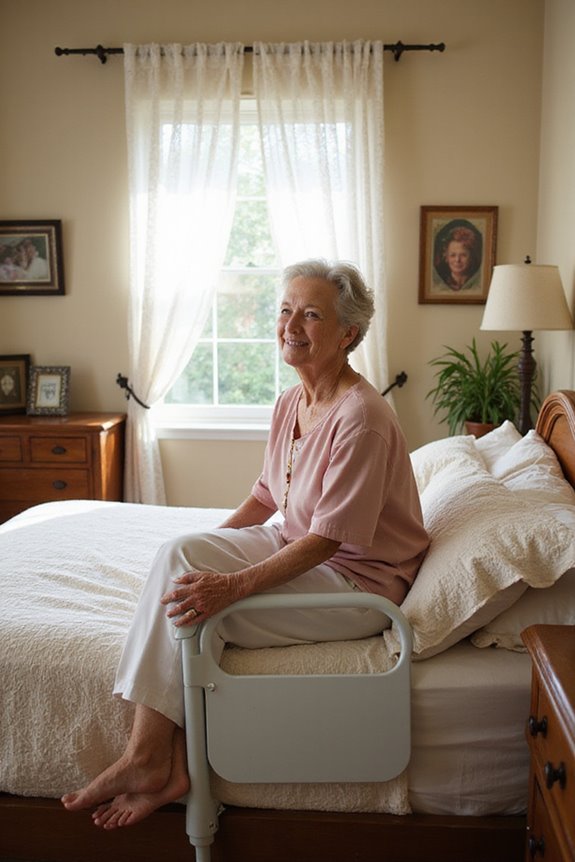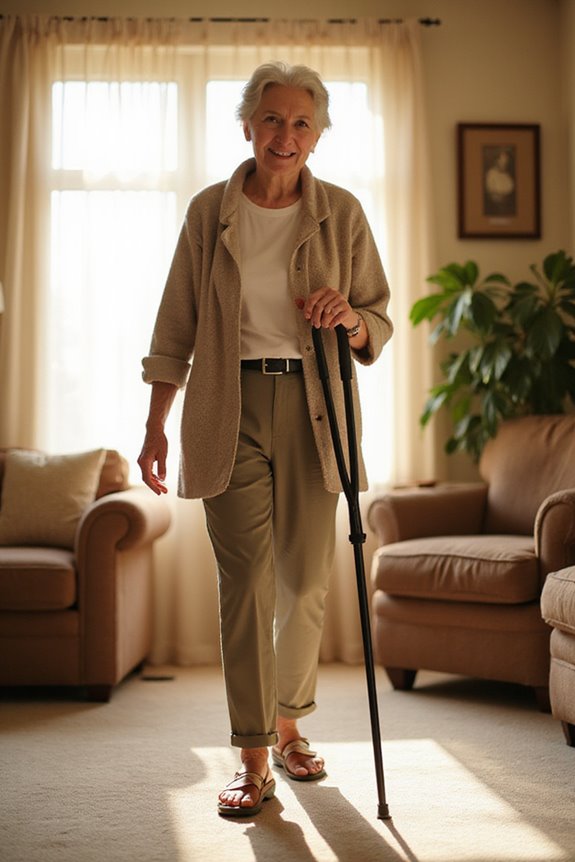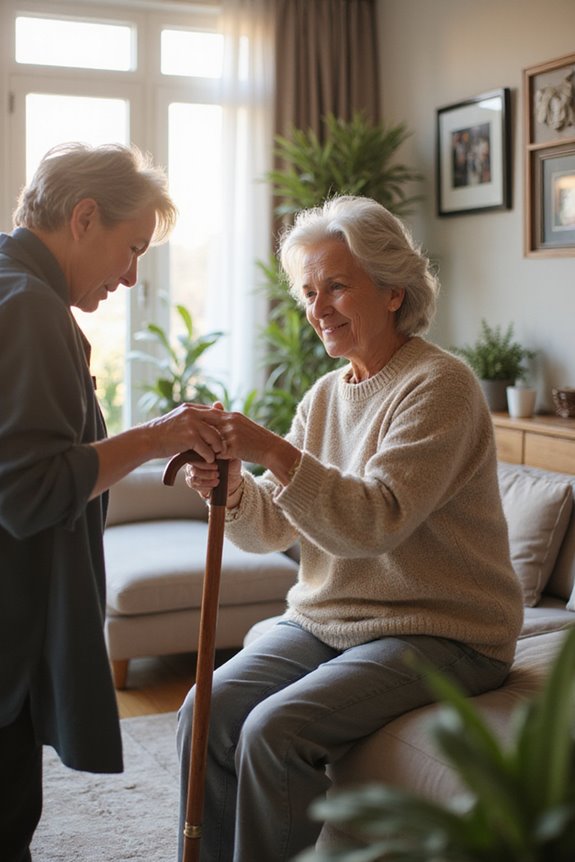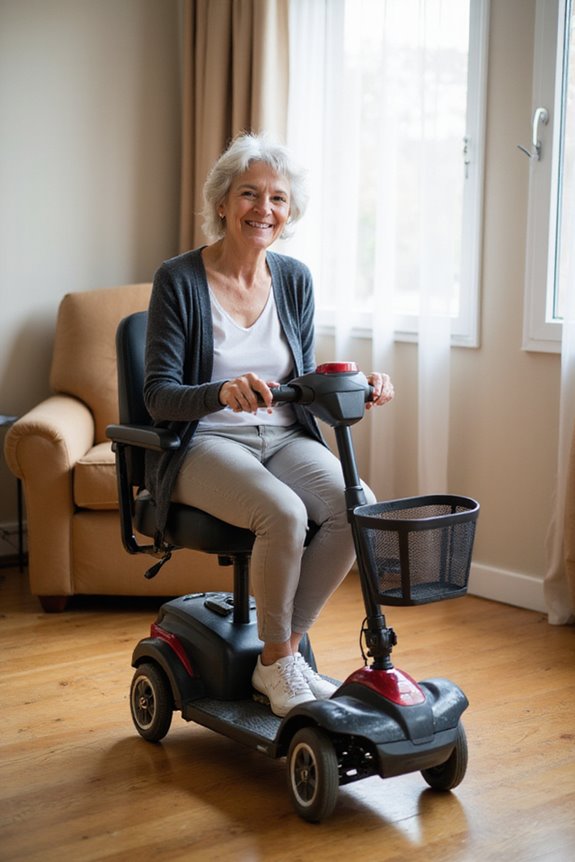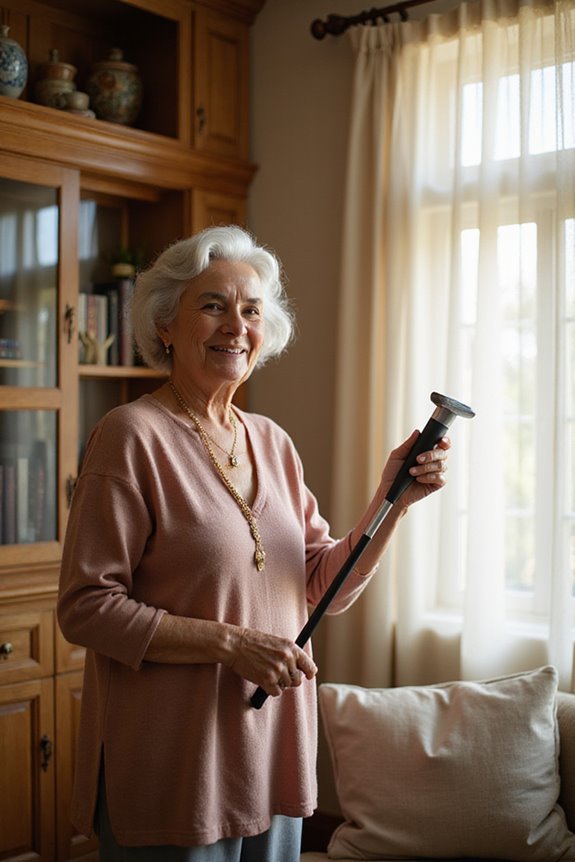Bed rail assists can pose safety risks for seniors despite their advantages. Risks include entrapment, falls, and physical injuries. Approximately 36,900 adults experience bed rail-related injuries annually in the U.S., with 83% of fatalities in those aged 60 and older. Benefits, such as reducing fall risk by 30% and improved mobility, exist. Guidelines for safe use include matching rail type to individual needs and regular inspections. For further insights into alternatives and strategies, additional information may be beneficial.
Key Takeaways
- Bed rails can minimize fall risks by providing stability, reducing fall-related events by 30% among seniors.
- However, they pose significant entrapment risks, especially for seniors with cognitive impairments, leading to serious injuries or fatalities.
- Proper selection and installation, adhering to weight capacity guidelines, is crucial for ensuring the safety of bed rails.
- Monthly inspections for wear and damage are essential to maintain the safety of installed bed rails.
- Alternatives like fall mats and mobility aids can enhance safety while promoting autonomy without the risks associated with bed rails.
Understanding the Risks of Bed Rails
When considering the use of bed rails for seniors, it is essential to acknowledge the inherent risks associated with their installation and use. Bed rail safety is a significant concern, particularly regarding entrapment risks. Seniors may become trapped between the rail and mattress, potentially leading to severe injuries or even asphyxiation.
Key risks include:
- Falls: Attempting to climb over rails often results in falls, causing fractures or head injuries.
- Minor injuries: Skin abrasions, cuts, and bruises can frequently occur from contact with bed rails.
- Psychological effects: The use of bed rails can lead to feelings of confinement and agitation.
Even when designed and installed correctly, bed rails remain hazardous, particularly for those with physical or cognitive limitations. Additionally, weight capacity considerations should be evaluated to ensure that any assistive equipment, including bed rails, is suitable for the user’s needs.
Bed Rail Incidents and Their Impact
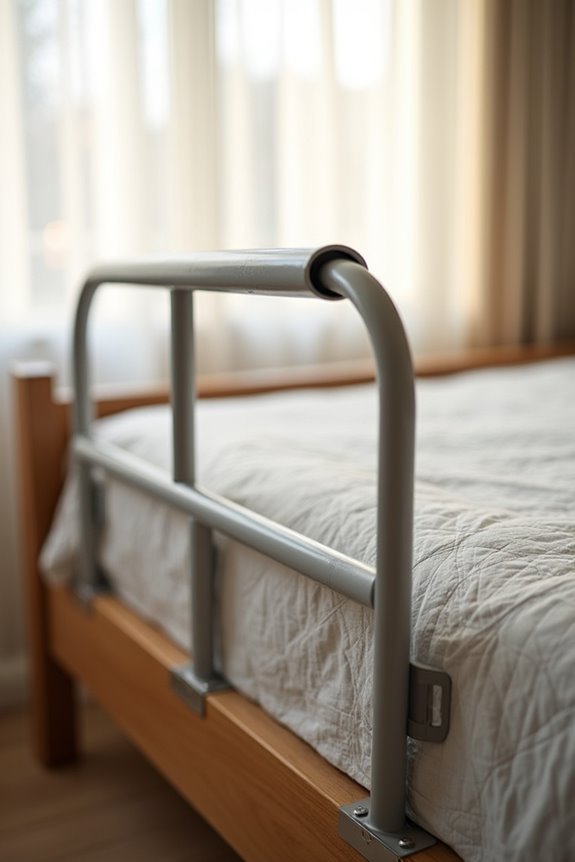
Bed rail incidents pose significant risks to the safety and well-being of seniors, particularly in long-term care settings.
Injury Statistics
- Approximately 36,900 adults suffer bed rail-related injuries annually in U.S. emergency departments.
- 93% of bed rail fatalities involve rail entrapment; 7% are due to falls on bed rails.
Demographics
- 83% of fatalities occur in individuals aged 60 and older.
- About 50% of victims have pre-existing medical conditions, such as dementia or cardiovascular issues.
Care Facility Concerns
- Since 1995, around 550 deaths among nursing home residents relate to bed rails.
- More than 50% of FDA-reported bed rail accidents result in patient death, indicating significant safety concerns in care environments. Additionally, the use of fall prevention mechanisms can enhance safety for elderly adults in bed.
Benefits of Using Bed Rails for Seniors
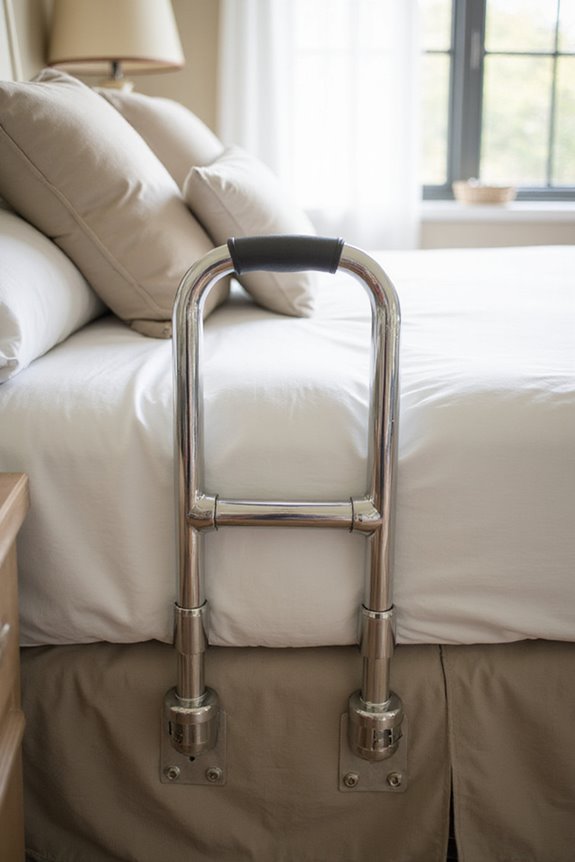
The use of bed rails for seniors offers numerous benefits that can greatly enhance their safety and quality of life.
Reduced Falls and Injuries
- Bed rails minimize fall risks, a primary cause of injury in seniors, reducing fall-related events by 30%.
- They decrease hospital admissions due to falls, as reported by the American Geriatrics Society.
Enhanced Mobility and Support
- Bed rails provide a sturdy handhold, aiding shifts between lying down and sitting up, thereby promoting independence.
- Research indicates 70% of seniors experience improved mobility with bed rails.
Increased Sense of Security
– Bed rails serve as a reassuring barrier, enhancing sleep quality and reducing anxiety about nighttime falls.
These factors underscore the bed rail effectiveness in promoting senior safety and well-being. Additionally, the use of grab bars in various settings can further ensure stability and support for seniors in their daily activities.
Guidelines for Safe Bed Rail Use
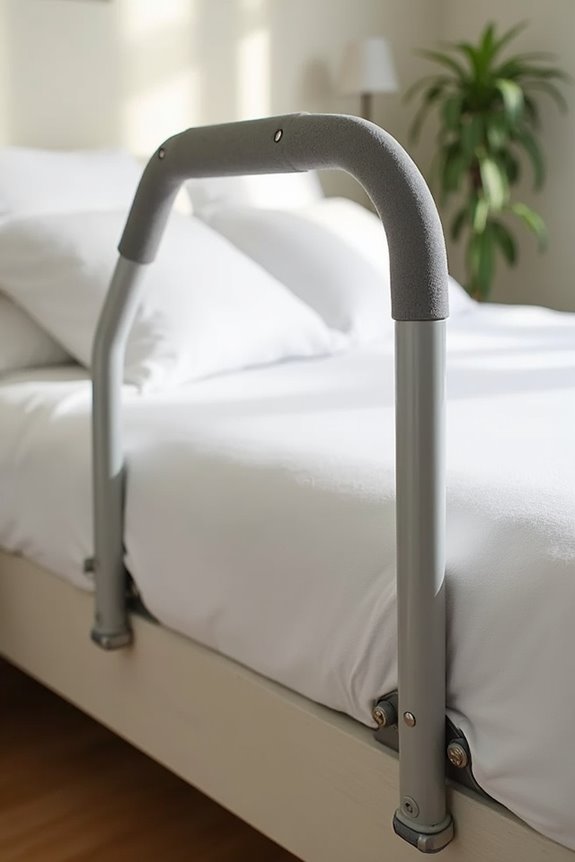
Assuring safe use of bed rails requires adherence to specific guidelines that prioritize senior well-being.
Bed Rail Types and Selection
- Match the bed rail type to the senior’s mobility and medical needs.
- Choose rails with a weight capacity between 250-400 lbs.
- Avoid full enclosure rails for seniors with cognitive impairments.
Installation Tips
- Follow manufacturer instructions for secure attachment.
- Install rails at least 4 inches above the mattress to prevent gaps.
- Use appropriate attachments, such as straps or bolts, for stability.
Regular Maintenance
- Inspect bed rails monthly for wear or damage.
- Replace any compromised rails immediately to mitigate risks.
- Monitor gaps to ascertain they remain within safe limits.
Regulatory Standards for Bed Rails
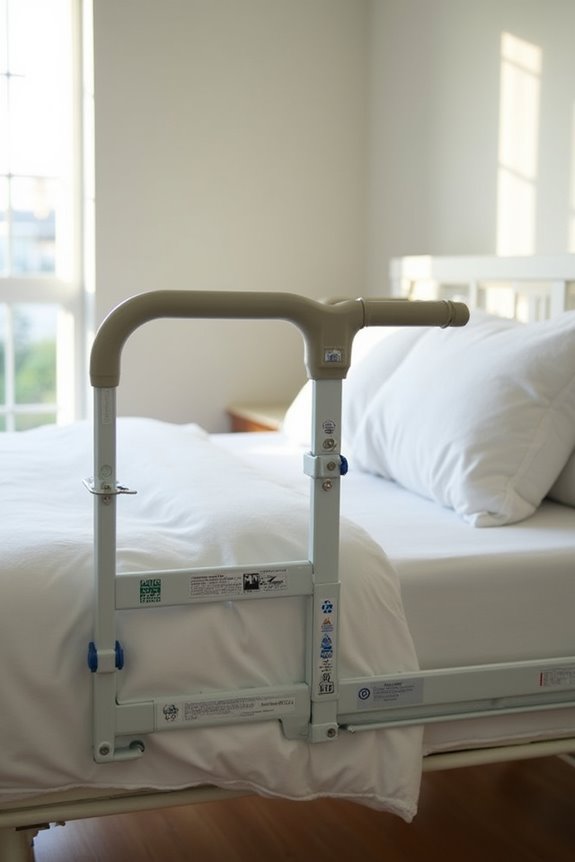
Regulatory standards for bed rails play an essential role in enhancing safety for seniors, as they establish guidelines that manufacturers must follow to minimize risks associated with bed rail use. The U.S. Consumer Product Safety Commission (CPSC) implemented a mandatory safety standard for adult portable bed rails effective August 21, 2023. This standard incorporates ASTM International’s ASTM F3186-17, ensuring regulatory compliance through safety testing.
Key components include:
- A top edge height of at least 4 inches above the thickest mattress to reduce entrapment.
- Performance tests for anchorage strength and stability.
- Clarity in labeling and manufacturer instructions to mitigate risks.
These regulations reflect a commitment to improving safety for seniors, even as alternative measures are encouraged. Additionally, the importance of user weight capacity is emphasized in safety designs to ensure bed rails can accommodate various individuals securely.
Common Injury Mechanisms Related to Bed Rails
Common injury mechanisms associated with bed rails pose significant safety concerns for seniors.
Entrapment Incidents
- Over 800 incidents reported by the FDA, with approximately 480 fatalities.
- 70% of deaths are suffocation cases linked to entrapment between the mattress and rail, particularly in individuals over 75.
Fall-Related Injuries
- Falls can occur over too-low rails or through gaps, resulting in fractures, contusions, or lacerations.
- An estimated 4,000 elderly patients are treated annually for bed rail-related injuries, excluding entrapments.
- Latch failures can cause rails to collapse, contributing to head trauma, accounting for about 18% of fatalities.
These statistics highlight the critical importance of evaluating bed rail safety to protect vulnerable seniors.
Assessing Individual Needs for Bed Rail Use
Evaluating individual needs for bed rail use requires a thorough evaluation of various factors that influence a senior’s safety and well-being.
Individual Assessment
- Conducted by a qualified health practitioner.
- Must consider medical, cognitive, and functional status in detail.
- Assessment should confirm risks without bed rails, documenting justifications for use.
Mobility Evaluation
- Assess bed mobility skills and transfer capabilities.
- Review muscle strength, balance, and coordination to gauge fall risks.
- Determine if the senior can safely exit the bed independently.
Cognitive Considerations
- Identify conditions like dementia or Parkinson’s that increase risks.
- Evaluate cognitive impairments affecting judgment or movement.
Personalized care plans must reflect each senior’s unique needs and preferences, ensuring bed rail use aligns with their desires for independence.
Alternatives to Bed Rails for Senior Safety
Considering the individual needs for bed rail use, it is imperative to explore alternative safety measures that can enhance senior well-being and independence.
Fall Prevention Devices
- Fall mats cushion impacts from falls.
- Bed exit alarms alert caregivers during unauthorized exits.
- Non-slip rugs improve footing.
- Low-height beds lessen fall severity.
- Hip protectors absorb impact during falls.
Mobility Aids
- Over-bed trapeze bars assist with repositioning.
- Bedside grab bars provide stable support.
- Adjustable beds facilitate easier access.
- Transfer belts aid caregivers during transfers.
- Wheelchairs or walkers nearby enhance mobility.
Additionally, incorporating bathroom safety handles can further reduce the risk of falls and enhance stability in essential areas of the home. These alternatives, alongside behavioral interventions and environmental modifications, create a safer living space while promoting autonomy, addressing common risks associated with traditional bed rail use.
Frequently Asked Questions
Can Bed Rails Be Used With Adjustable Beds?
When considering adjustable bed compatibility, one must navigate safety concerns. Specialized bed rails designed for adjustable beds can offer support, yet careful selection and regular checks are essential to guarantee a secure and harmonious sleep environment.
What Are the Different Types of Bed Rails Available?
Various types of bed rails available include full-length and half-length options, each offering distinct safety features. These rails cater to different mobility needs, enhancing comfort and security for individuals seeking support during bed changes.
Are There Specific Bed Rail Brands Recommended for Safety?
Over 50% of bed rail incidents result in death, emphasizing the importance of brand reliability and safety ratings. However, no specific brands are universally recommended; effective use and patient assessment are paramount for safety.
How Often Should Bed Rails Be Inspected for Safety?
Inspection frequency for bed rails should align with safety standards, recommending monthly checks. For those with cognitive impairments or frequent use, weekly inspections enhance safety, ensuring structural integrity and preventing potential hazards during use.
Can Bed Rails Be Customized for Individual Needs?
Bed rails can indeed be customized for individual needs, featuring personalized features and tailored designs. These adjustments enhance safety and comfort, fostering a sense of belonging for users by ensuring their specific requirements are met effectively.

